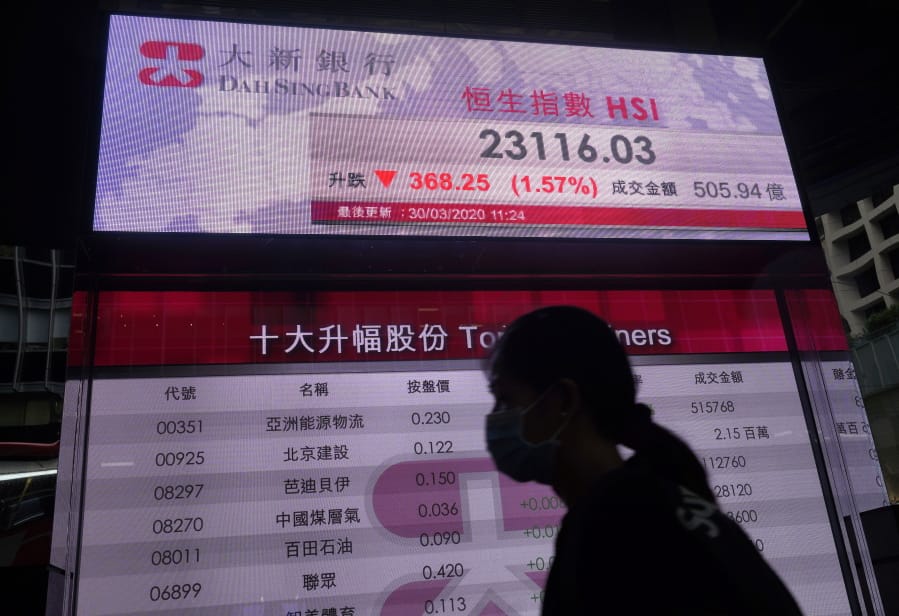
NEW YORK — U.S. stocks are pushing higher Monday, led by big gains for health care companies announcing developments that could aid in the coronavirus outbreak. But markets around the world remain tentative amid uncertainty about whether global authorities can do enough to nurse the economy through the pandemic.
The S&P 500 was up more than 2 percent in midday trading, renewing gains after falling close to the flatline. European markets were mixed after paring earlier losses. Asian markets were down, but by more modest degrees than the huge swings that have rocked investors over the last month.
A surge for health care stocks led the way. Abbott Laboratories jumped 8 percent after saying it has a test that can detect the new coronavirus in as little as five minutes. Johnson & Johnson leaped 7.5 percent after it said it expects to begin human clinical studies on a vaccine candidate for COVID-19 by September.
A 2 percent gain for the S&P 500 would have been a big deal earlier this year. But it would count as one of the market’s milder days since the outbreak sliced roughly a quarter off the S&P 500 over the last six weeks. On one hand, investors are weighing an economic downturn that could exceed even the Great Recession, as the pandemic forces businesses around the world to shut down to slow the spread of the virus. On the other, investors are hopeful that the weakness could be relatively short-lived and that the massive amounts of economic aid offered by central banks and governments can fill the gap in the meantime.
Some of Monday’s sharpest action was in the oil market, where benchmark U.S. crude fell more than 5 percent and dropped below $20 per barrel for the first time since early 2002. Oil started the year above $60, and prices have plunged on expectations that a weakened global economy will burn less fuel. The world is awash in oil, meanwhile, as producers continue to pull more of it out of the ground.
The S&P 500 was up 2.3 percent, as of 11:24 a.m. Eastern time. The Dow Jones Industrial Average gained 460 points, or 2.1 percent, to 22,097, and the Nasadaq was up 2.6 percent.
The moves follow last week’s stellar performance, where the S&P 500 surged 10.2 percent for its biggest weekly gain since the market hit bottom in 2009 following the financial crisis.
Most voices on Wall Street are telling investors to prepare for more losses, but the possibility of a new bull market emerging has the first green shoots of optimism appearing.
Congress last week passed a $2 trillion rescue package for the economy, and the Federal Reserve promised to buy as many Treasurys as it takes to get lending markets working smoothly. Forced selling by investors looking to raise cash may also be easing, and Morgan Stanley strategists said the worst may be behind us. They say another pullback in stocks is likely, but current levels offer some buying points for investors willing to wait six to 12 months.
Goldman Sachs, though, warned the market will likely turn lower in coming weeks. One factor against markets is that companies aren’t buying back as much of their stock as politicians have railed against repurchases made by airlines and other big companies before the outbreak. Any slowdown in buybacks will have a big impact because companies themselves have been the single biggest source of demand for U.S. stocks in recent years, according to Goldman Sachs.
Most investors say they expect markets to remain extremely volatile until the virus slows its spread. Until then, investors won’t know how long the economic downturn will ultimately last. In a sign of increased caution, the yield on the 10-year Treasury fell to 0.62 percent from 0.74 percent late Friday.
The number of known infections around the world has topped 741,000. The United States has the highest number in the world, more than 143,000. More than 156,000 people around the world have also recovered.
Most people who contract COVID-19 have mild or moderate symptoms, which can include fever and cough but also milder cases of pneumonia, sometimes requiring hospitalization. The risk of death is greater for older adults and people with other health problems.
President Donald Trump extended restrictive social distancing guidelines through April, bowing to public health experts who presented him with even more dire projections for the expanding coronavirus pandemic.
"care" - Google News
March 30, 2020 at 11:59PM
https://ift.tt/2URPE7I
Wall Street pushes higher, led by surging health care stocks - The Columbian
"care" - Google News
https://ift.tt/2N6arSB
Shoes Man Tutorial
Pos News Update
Meme Update
Korean Entertainment News
Japan News Update
Bagikan Berita Ini














0 Response to "Wall Street pushes higher, led by surging health care stocks - The Columbian"
Post a Comment